| |
Photo by Rebecca Gammill
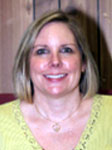
In the six years that I have worked for North
Georgia RESA as a Mathematics Mentor, I have been fortunate to work
with math educators in school districts and across the state of
Georgia. As a member of the GCTM Executive Committee since 2012, I
have also had the opportunity to interact with others from all over
the United States and even experts from other countries. During this
time, I have seen incredible changes in student and teacher
understanding and engagement in mathematics. As math educators, we
still have room for growth; however, we have made great strides in a
relatively short amount of time.
As I work with groups of teachers, I am noticing
that teachers are working to get better at improving questioning
skills, having students explain their thinking, differentiating
instruction, and helping students make connections between the
mathematical concepts their students are learning. I am humbled by
the number of teachers who ask for more training in the use of
manipulatives or Number Talks or other strategies so that their
students will have additional opportunities to excel.
My 7-year-old grandson, Avrey, was skip counting
by 11 and 12 at the end of 1st grade. When a teacher friend asked
him, he was able to explain that he just adds 10 and 2 more to get
the next number. It warmed my heart when he said, "My teacher gave
me problems like that last year." He also traveled with me to one of
the Summer Academies, and several of my colleagues worked with him
and asked questions. His response to one of them was, "Thank you,
Ms. Paulette, for working with me. Give me some more!" If all my
grandson's teachers nurture him like this, he will be able to do
anything and go anywhere he wants.
I have been asked by teachers and leaders from
other states about several of the resources we have available to us
in Georgia. Many of these out-of-state teachers use the Georgia
Frameworks as their curriculum. They are encouraged to know that
these were designed by Georgia teachers and are revised frequently.
While attending NCTM Leaders' Affiliate Conferences over the past
few summers, the GCTM representatives have been asked to lead
sessions about the Georgia Math Conference, the GCTM Summer
Academies, "Math Day at the Capitol," and our other advocacy
efforts. This is very encouraging and makes me confident that
Georgia is moving in the right direction and that GCTM continues to
lead the way for our friends across the nation.
I am so proud of our Georgia teachers! You pour
your hearts and souls (and money) into what you do every day. You
play with blocks and you draw pictures. You sing songs and build
models. You create learners and problem solvers. You introduce
dissonance to the student who has never had to think deeply. You
make a difference! Thank you for sharing your calling with the
students of Georgia.
Back to Top
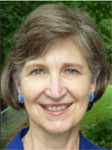
Just under one hundred individuals including
Governor Deal, Lieutenant Governor Cagle, State School
Superintendent Richard Woods, Georgia Board of Education members,
and key legislators received an invitation to the upcoming Georgia
Mathematics Conference. We reached out personally to those who live
in close proximity to Rock Eagle to encourage their attendance, and
at least two senators committed tentatively to attend.

The next Math Day at the Capitol will be Tuesday,
February 13, 2018. Senator Chuck Hufstetler from Rome, GA will
sponsor the resolution for Math Day again this year. Like last year,
GCTM will provide boxed lunches for invited members of the
legislature where they can visit with a few GCTM officers and
discuss the interests of GCTM and the importance of a quality
mathematics education.

TJ Kaplan, the legislative consultant for GCTM,
provides updates on education-related issues that might be of
interest to GCTM. The following analysis provides insights from
GCTM's advocacy team on key state elections for 2018. Winners of
these elections will help shape state education policy in the
subsequent years.
For the first time in 12 years, both Governor and Lt. Governor will
be open seats. With Governor Deal being term-limited, and Lt.
Governor Casey Cagle announcing his run for Governor, there will
also be numerous open seats down the ballot. Lt. Gov. Cagle will
face challenges from multiple incumbent elected officials but his
showing (nearly $2.6 million) in the first disclosure report clearly
sets him apart from other candidates for Governor. Challengers
include incumbent Secretary of State Brian Kemp (R-Athens, $1.7
million), State Sen. Hunter Hill (R-Atlanta, $1.1 million), State
Sen. Michael Williams (R-Cumming, $1 million), former House Minority
Leader Stacey Abrams (D-Atlanta, $541,000), and State Rep. Stacey
Evans (D-Marietta, $415,000). Clay Tippins, Executive
Vice-President at Capgemini and nephew of Senate Education Chairman
Lindsey Tippins (R-Marietta) has also filed for Governor but did so
after the first financial disclosure reporting deadline. These
amounts were disclosed for the June 30, 2017, deadline and reflect
fundraising totals since the time each candidate qualified. The
next disclosure deadline is December 31, 2017.
In addition to the high-profile race for Governor in 2018, several
down-ballot races will draw media attention and fundraising dollars.
The race for Lieutenant Governor saw three candidates qualify and
report their fundraising efforts by the June 2017 deadline, although
other candidates are reported to be exploring a run. Senate
President Pro Tempore David Shafer (D-Duluth) leads the pack with
one of the largest fundraising hauls for the office in Georgia
history, followed by Senator Rick Jeffares (R-McDonough) and Rep.
Geoff Duncan (R-Cumming). In the race for State School
Superintendent, incumbent Republican Richard Woods has announced
that he will run for reelection. Sonia Francis-Rolle has filed to
run as a Republican while Democrats Dr. Sid Chapman (President of
the Georgia Association of Educators), Otha Thornton (immediate past
president of the National PTA), and Samuel Mosteller (minister and
former principal) have announced that they will also run for the
office.
There are a number of State House and Senate districts that are
consistently competitive or have become more competitive in recent
years as a result of shifting demographics. House District 40 and
House District 80 were both flipped in 2016 and will likely feature
fierce battles in 2018. Another interesting race will likely play
out in House District 105 where Rep. Brian Strickland (R-McDonough)
is expected to run for Sen. Rick Jeffares' (R-McDonough) seat. (Sen.
Jeffares is running for Lt. Governor).
The additional fallout will occur within the
House and Senate Majority Caucuses as retirements lead to open
chairmanships. The data show that there will likely be more than 40
percent turnover in the legislature between 2015 and 2018. The
anticipated retirement of longtime committee chairmen will leave
large gaps in institutional knowledge and present a plethora of
opportunities to cultivate new key influencers as allies.
Although we do not support particular candidates for office, your
GCTM team will continue to monitor these key elections and make
regular reports on relevant developments.
Back to Top
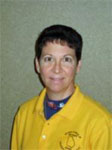
The Executive Committee is pleased to report that
The Georgia Council of Teachers of Mathematics, Inc. is now
designated a public charity exempt from federal income tax under
Internal Revenue Code Section 501(c)(3) effective January 1, 2017.
Donors to GCTM can now deduct contributions made under IRC Section
170, and GCTM is qualified to receive tax deductible bequests,
devices, transfers, or gifts under Section 2055, 2106, or 2522.
GCTM will maintain a list of its donors and grantors and the amount
of cash contributions or grants (or a description of the noncash
contributions) received from each. For tax deduction purposes, each
donor will receive written acknowledgment from GCTM of the
contribution including the date and amount of any cash contribution,
and description of any non-cash contributions and whether any goods
or services were provided in return for the contribution.
Please address any questions to:
Nicole Ice, Ph.D.
Treasurer
The Georgia Council of Teachers of Mathematics, Inc.
P.O. Box 683905
Marietta, GA 30068
Back to Top
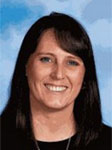
Summertime: A time for relaxation, a time for
fun, a time for family, and a time for growth...growth of your
personal and professional self!
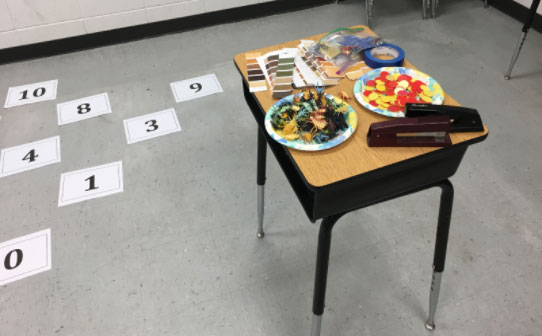
Over 550 teachers participated in professional
growth with the 2017 Summer Mathematics Academies with GCTM. The
teachers learned many things throughout the two-day academy. A heavy
focus was placed on the eight effective teaching practices from the
book, "Principles to Action: Ensuring Mathematical Success for All".
Teachers learned how to establish goals within lessons in order to
focus the students learning and to guide instructional decisions.
Tasks for each grade level and goals associated with these tasks
were used to develop the conversation amongst teachers and to
facilitate mathematical discourse about the math and about the
classroom. Teachers practiced using purposeful questions to guide
the lessons and to help students reason about the math and to make
sense of the important ideas and relationships. Teachers used
productive struggle to increase their knowledge of classroom
strategies and mathematical ideas. In the words of a participant,
"It is Ok and appropriate to let our students struggle and that they
learn more from that."
Video about Productive Struggle
During the Summer Academies teachers participated
in grade level activities focused on standards for that grade band.
They were able to walk away from the academy and immediately use the
tasks with students. Many teachers experienced new manipulatives,
new activities, and new games to support student learning. A
Lunch-N-Learn was provided at each academy where teachers received a
free lunch and the opportunity to learn about 3 Act Tasks. Teachers
walked away from the one-hour lunch with free resources to fully
engage their students in real-life problem-solving activities. Other
teachers learned more from the tasks within the class where they not
only learned the strategies for implementing problems in the
classroom but also played along with each other while enjoying the
numbers!
Video of Teachers Playing a Game

During the summer of 2017, these teachers focused
on professional growth! They grew their mathematical mindset, their
toolbelt of strategies, and their knowledge of math. They grew their
circle of collaborators until they had friends from other districts
and schools. The knowledge and experiences they gained during these
two days are invaluable to them and their students. Grow your math
mind!
Video about Collaborating
Join us for mathematical fun during the summer of
2018...more information about times and locations available at GMC!
Back to Top
Abstract: To deepen students'
understanding of fractions a variety of representations, methods,
explanations, and justifications should be presented. When asking
students to visually represent a given fraction, we likely get
different yet equivalent representations. However, for a given
visual representation, there may be several correct answers,
depending on our "whole."
Fractions: Not Always a Two-Way Street
Students need a strong understanding of fractions as a launching pad
for further progress in mathematics, particularly in algebra, which
is a foundation for higher-level mathematics (Wu 2002, Fennell 2007,
NMAP 2008, Wu 2014). However, the subject of fractions continues to
be difficult for many students (Hecht, Vagi, & Torgeson 2007;
Mazzocco & Devlin 2008; NMAP 2008), leading to further implications
for their mathematical studies or careers. An effective way to help
students understand fractions more deeply is to present a variety of
representations, methods, explanations, and justifications (Harvey,
2012; Pantziara & Philippou, 2012, Cramer & Henry, 2002; Siebert &
Gaskin, 2006). By using this approach, several different yet
equivalent visual representations of a single fraction can be
explored in order to help students better understand its value. With
this technique in mind, we must examine the opposite direction--that
is, for one given visual representation, are there several correct
fractions, or is there only one correct fraction (or an equivalent
one) that represents the visual? In this article, the authors
include tasks and student responses designed to help teachers
uncover some common misconceptions so that they are better prepared
when introducing fractions to their own students.
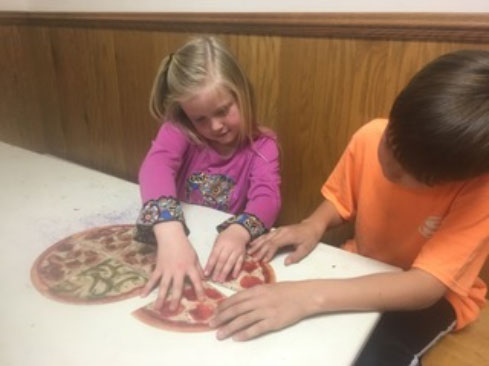
Read more.
| Dr. Heidi Eisenreich is an
Assistant Professor of Mathematics Education at Georgia
Southern University and a 2017 STaR (Service, Teaching, and
Research) fellow through AMTE (Association of Mathematics
Teacher Educators). Her interests lie in finding meaningful
tasks that push beliefs about mathematics teaching and
learning through discourse and reflecting on those tasks
with preservice teachers, inservice teachers, and parents.
She earned her Ph.D. in Mathematics Education from the
University of Central Florida in Orlando. |
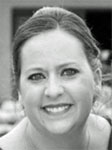 |
| Currently an Assistant Professor
of Mathematics Education at Georgia Southern University, Dr.
Ha Nguyen has taught mathematics courses and mathematics
content courses for pre-service teachers as well as
providing professional development for K-12 in-service
teachers in Georgia. She was a Project NExT (New Experiences
in Teaching) Blue'10 Fellow through the professional
development program of the Mathematical Association of
America. She is interested in students' understanding and
thinking of mathematics and how to make mathematics relevant
to students. |
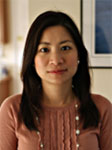 |
| Dr. Joy Darley currently has the
title of Associate Professor of Mathematics Emerita at
Georgia Southern University and serves on the executive
board for GCTM. Prior to her retirement in 2016, she taught
mathematics content courses for pre-service teachers at
Georgia Southern University. She is interested in both
students' and pre-service teachers; conceptual understanding
of mathematics, especially fractions and the arithmetic to
algebra connection. |
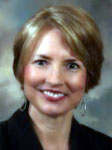 |
Back to Top
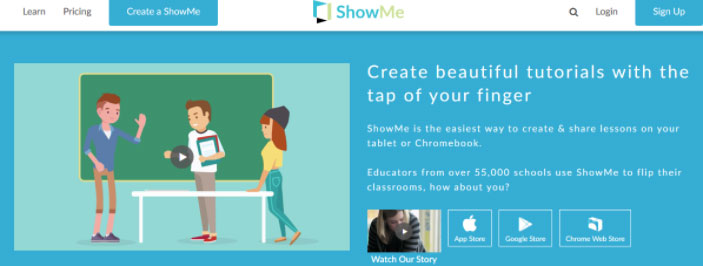

I have recently incorporated the Showme app into
my instructional practices. This interactive whiteboard application
allows me to develop mathematical literacy to my students. Before I
get into how I use the application in my classroom, let's first take
a look at the application itself and why I choose to use this
interactive whiteboard.
While searching for a way to better communicate mathematics to my
students outside of the classroom I came across the idea of using an
interactive whiteboard on my tablet. I knew I needed an interactive
whiteboard that will record my annotations and my voice. This is why
I chose the ShowMe
app. The app is available for purchase in the iTunes store
and Google play for a small fee. The app lets the user record their
annotation and their voice simultaneously; it also has the option to
upload pictures that you may annotate, such as the Cartesian plane.
Once finished recording the user has the option to email the
recording or upload the video onto a website. There is a quick
learning curve for using the program, and I found the program simple
and easy to learn. I have found the use in the ShowMe app through
answering emails from students by sending a video, one on one
discussions with students where we use the app to discuss the
proposed topic, and creating videos that review the solutions to
assessments.
When answering emails from students I am able to use the ShowMe app
to answer the questions and, more importantly, to show a visual
representation of the answer. The Showme app allows me to dive
deeper into the content remotely. Positive feedback from my students
indicates that they seem to enjoy the recordings and understand the
material better than a simple written out solution. The app is able
to capture the real-life explanation to the student's question; it
is as if the student is attending a private lecture that covers
their question. It takes very minimum time to record and I have
found that I spend more time discussing the topic instead of
answering the question; hence, the student is obtaining the answer
and is also developing a deeper understanding of the material. As an
example, imagine if a student asked you to solve a basic quadratic
equation. Consider the following exchange between student and
teacher.
Email from student: Good afternoon Professor, I have a
quick question. How do I solve the following equation x2-4=0?
Thanks!
Email to student: Hello, we are dealing with a quadratic
equation. Therefore, we must be sure that the equation is set
equal to 0. We see that the equation is set equal to zero. We
will now see if x2-4 is factorable; if we are able to
factor the expression then we can apply the Zero-Product
Theorem. Observe, x2-4=(x+2)(x-2). Thus, we have the
following (x+2)(x-2)=0. Which implies that x+2=0 or x-2=0.
Consequently, x=-2 or x=2. Be sure to check the solutions!
It is an easy task to write a solution using a document writer, as
illustrated above. However, with the use of the app, you are able to
answer the question by showing and explaining the steps in solving
the equation. Furthermore, you are able to show the visual
representation of the equation and the solutions. This process helps
the student to better understand how to solve the equation but, more
importantly, they understand the meaning behind the solution.

I also use the app to answer questions in my
office. When I meet with students in my office we use the app to
discuss the proposed subject matter. Once the meeting is finished, I
send the recording of the discussion to the student. This gives the
students the pleasure of not taking notes during the meeting, to
give all attention to the discussion, and to review the discussion
at later times.
Another great use of the ShowMe app is for covering the
solutions for test. Instead of having a class set aside for the
specific task, I record the solutions and explanations using the
app. Then, I send the recording to the students once the test is
finished. I have found that students who do poorly on the test are
able to see the mistakes that they have made, and they are also
learning from the mistakes that they have made in hopes to develop
the understanding of the content. For the students who did well on
the exam, the recording will be a great way for students to review
for a comprehensive exam. In both situations, we are able to move to
new material without getting bogged down in the previous work. For
college instructors, this can be a vital tool to stay on your pacing
guide. For secondary instructors, this can be a great way to use
differentiation. The app also has the capability of creating videos
that can be remotely assigned through email or class blogs. After
giving the assigned videos, students are better prepared to work on
in-class assignments related to the video content--much like in a
flipped classroom.
The ShowMe app has been a blessing in my classes. I am not only able
to send answers to the students' questions but also recordings to
explain mathematical content. This process affords me the ability to
stay on pace with the subject matter and while developing the
confidence that my students have the opportunity to review material
that has already been assessed. Although sending recordings to
students is a great way to communicate the material, there is no
substitution for written explanations. Students need to develop the
skills to mathematically communicate through reading and writing in
a mathematical language. Just keep in mind that this app is a great
tool for developing mathematical literacy, but it is the
responsibility of the instructor to not let it replace or take away
from the beauty of reading and writing in mathematics.
A native of Southern Georgia, Andrew Shealy
serves as a Lecturer of Mathematics at Mercer University. He earned
his B.S. and M.S. in Mathematics, and has successfully completed the
GaTapp program. Before Mercer University, he served as an Instructor
of Mathematics at a State College and a Teacher of Mathematics at a
High-School, both of which in Georgia. Although trained in
Combinatorial Design Theory, his current research interests are
found in mathematics education.
Back to Top
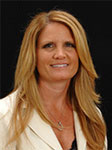 Are we teaching NEW, NEW Math?? Our math
standards and methods for teaching have been controversial since
1788 regarding teaching conceptually vs. skills and practice. Dottie
Whitlow gave a great review of the history component in the book
Balancing the Equation written by current NCTM President, Matt
Larsen and author Tim Kanold in the spring edition of Reflections
this year. She shared the history of the pendulum shift for over 200
years on how students should learn mathematics. Are we teaching NEW, NEW Math?? Our math
standards and methods for teaching have been controversial since
1788 regarding teaching conceptually vs. skills and practice. Dottie
Whitlow gave a great review of the history component in the book
Balancing the Equation written by current NCTM President, Matt
Larsen and author Tim Kanold in the spring edition of Reflections
this year. She shared the history of the pendulum shift for over 200
years on how students should learn mathematics.
The answer is a balance of understanding and
skills, hence the book Balancing the Equation. The how to do math,
when to apply math, and why math works, is the premise. This book
was published in 2016 and was written for teachers, administrators,
school board members, math program leaders, coaches, professors, and
parents. The purpose was to clarify misunderstandings regarding our
standards through accurate information and research, and in turn,
support the future math learning of our students.
The highlights of the book include:
-
Why does mathematics education need to
improve?
-
A brief history of mathematics education
-
The common core math debate
-
The equilibrium position and effective
mathematics instruction
-
How to help your child learn
mathematics-focusing on parents
-
Conclusion and action steps
-
Resources for parents
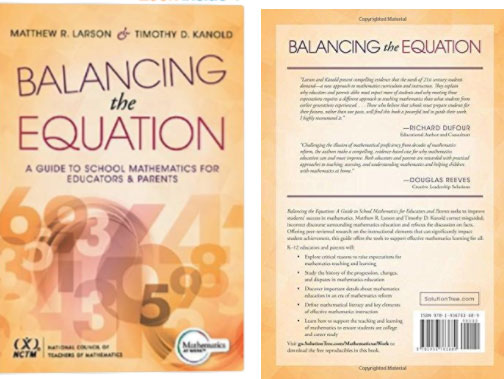
I highly recommend this book for every teacher
and administrator to read for the background knowledge and
understanding of our current GSE standards and research-based
instruction. It is an easy read and does a great job clarifying the
misconceptions so commonly seen in social media. This would be a
great resource to promote mathematical discourse!
Interested winning a free copy of this book?
Consider attending the Georgia Mathematics Conference on Thursday
(2:15 - 3:15 in the Callaway Building) to participate in the session
titled Mathematics Leadership in Education & Instruction: Promoting
mathematical discourse with stakeholders beyond the four walls of
your classroom.
During this session, you will discuss how
mathematics education is promoted in various contexts. Join the
panel of experts to learn how to pave the way for collaborative
opportunities with our stakeholders at large. Walk away with
strategies in promoting transparency and understanding of our
mathematics standards and instruction, for the success of student
learning. Balancing the Equation by Tim Kanold and Matt Larsen (GMC
2018 Keynote) will be given away to lucky winners!
The panel participants will include:
-
Vinnie Prasad, Teacher/Coach/Parent Liaison
-
Angela Stewart, Principal
-
Michelle Mikes, Math Supervisor
-
Terry Haney, RESA Representative
-
Sandi Woodall, Math Program Coordinator,
GaDOE
-
TJ Kaplan, Legislative Consultant for GCTM
Hope to see you there!
Back to Top
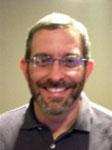
This past summer, I had the opportunity to
facilitate the Geometry (Analytic Geometry) class at the GCTM Summer
Academies. Not only did I enjoy meeting teachers from areas all over
the state of Georgia, I was able to both share and receive great
ideas for my personal teaching practice, especially in the area of
Geometry.
 After
the first day's sessions, I gave the participants an opportunity to
ask questions anonymously to make sure we covered as many topics as
possible on the second day. A common question was "could we go over
strategies to cover the standards most effectively for the EOC
Milestone?" Although our seminar focus was not to do "teaching to
the test" strategies, the question is a legitimate concern in this
era of high stakes testing. In response to this question, I thought
about some of the practices I use in the classroom to teach material
as it would naturally develop or make sense in the learning process.
When I look at a curriculum map, such as the one developed for
Geometry, I try to consider why we teach the topics in that
particular order or whether there is a better logical way to
approach the standards that would make sense to my students. After
the first day's sessions, I gave the participants an opportunity to
ask questions anonymously to make sure we covered as many topics as
possible on the second day. A common question was "could we go over
strategies to cover the standards most effectively for the EOC
Milestone?" Although our seminar focus was not to do "teaching to
the test" strategies, the question is a legitimate concern in this
era of high stakes testing. In response to this question, I thought
about some of the practices I use in the classroom to teach material
as it would naturally develop or make sense in the learning process.
When I look at a curriculum map, such as the one developed for
Geometry, I try to consider why we teach the topics in that
particular order or whether there is a better logical way to
approach the standards that would make sense to my students.
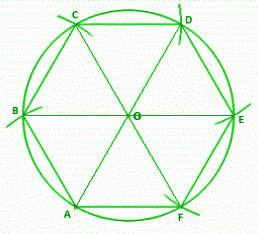 For
example, in my earlier years of teaching the standards on Geometric
Constructions, I would take a few days with a class set of compasses
in tow and cover every construction that could possibly be asked on
the EOC Milestone. We might pause to enjoy a few extraneous
constructions such as the 6 petal "flower" (which leads to the
hexagon). When we had more time for projects (before Milestones), I
would even assign students to construct their own snowflake using
geometric constructions. Yet overall, constructions was a unit of
its own with little connection to the other geometric topics. For
example, in my earlier years of teaching the standards on Geometric
Constructions, I would take a few days with a class set of compasses
in tow and cover every construction that could possibly be asked on
the EOC Milestone. We might pause to enjoy a few extraneous
constructions such as the 6 petal "flower" (which leads to the
hexagon). When we had more time for projects (before Milestones), I
would even assign students to construct their own snowflake using
geometric constructions. Yet overall, constructions was a unit of
its own with little connection to the other geometric topics.
More recently, I've reconsidered the purpose of teaching
constructions. By design, constructions are a way to reinforce the
properties and relationships that are being discussed in other
geometric topics. So why not spread out the constructions to when
they are needed in other parts of the curriculum? I propose some of
the following times to use a construction in context:
 Bisect
a Segment: when exploring properties of a perpendicular
bisector to the base of an isosceles triangle Bisect
a Segment: when exploring properties of a perpendicular
bisector to the base of an isosceles triangle
Constructing a Line Parallel to a Given Line Through a Point Not on
the Line: when exploring properties of parallel lines and
corresponding angles.
Construct an Equilateral Triangle: go ahead and drop an altitude
(through construction) and introduce trigonometric ratios with a
30-60-90 triangle.
Construct a Square or Hexagon Inscribed in a Circle: discuss
rotational symmetry or inscribed angle properties.
Almost every geometric construction can be used
within the context of the curriculum. This approach makes
constructions a teaching tool instead of a separate two to three-day
unit. Since constructions are active based learning, students tend
to be more engaged in the learning process and are using the compass
throughout the semester instead of one week. I have even found that
staggering the constructions within the curriculum tends to save a
day or two of instruction in the overall picture of the semester or
year. This instructional revelation would not have been possible if
not for the shared dialogue that took place at the Summer Academies.
Continue the discussion with us
Georgia Mathematics Conference this year. We hope to see you
there.
Back to Top
GMC Update
by
Dr. David W.
Thacker, GMC Program Chairperson |
The 2017 Georgia Mathematics Conference will be
held on Oct 18-20th at the Rock Eagle 4-H Center
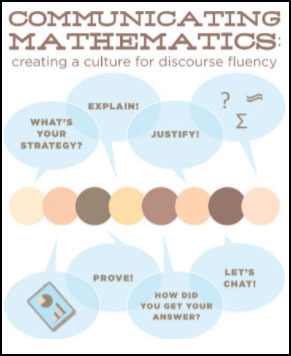 This
year's theme is "Communicating Mathematics: Creating a Culture for
Discourse Fluency." This
year's theme is "Communicating Mathematics: Creating a Culture for
Discourse Fluency."
What is this "discourse" of which we speak? Discourse can be messy,
and there is no single course of action or step-by-step linear
approach that says discourse starts here and finishes over here.
Discourse is on-going, circuitous, and reflective. Discourse
includes students, mathematics educators, all types of support
personnel at the school, district, regional, state, national, and
international levels, and the communities/families at-large.
Further, discourse can occur through a variety of platforms,
including face-to-face, peer-to-peer, student-to-teacher and vice
versa, teacher-to-teacher, etc., through digital environments, and
others not even realized. Discourse also occurs through spoken
ideas, written ideas, reading of text, listening, social media
environments, such as blogs, and much more. Keynote speakers
include:
| Christine (Chris) Franklin is
the K-12 Statistics Ambassador for the American Statistical
Association and elected Fellow. She is retired from the
University of Georgia after 36 years as the Lothar Tresp
Honoratus Honors Professor and Senior Lecturer Emeritus in
Statistics. She is the co-author of two Introductory
Statistics textbooks and has published more than 50 journal
articles and book chapters. Chris was the lead writer for
the American Statistical Association Pre-K-12 Guidelines for
the Assessment and Instruction in Statistics Education (GAISE)
Framework and chaired the writing team of the ASA
Statistical Education of Teachers (SET) report. Chris
completed her term serving as the Advanced Placement
Statistics Chief Reader in July 2009. She has been honored
nationally by her peers with the Mu Sigma Rho National
Statistical Education Award, the United States Conference on
Teaching Statistics (USCOTS) biennial lifetime achievement
award, and the ASA prestigious Founders Award. She was a
2014-15 Fulbright Scholar, spending six months at the
University of Auckland, New Zealand working with statistics
educators on the project, "Implementing K-12 Statistics
Standards: Comparing Practices in New Zealand and the United
States". She also spent time with mathematics and statistics
educators at the University of Tasmania.
Oct 18 (Wednesday Evening) |
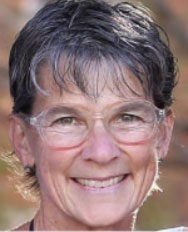 |
Sunil Singh is the author of
Pi of Life: The Hidden Happiness of Mathematics and a Lead
Ambassador of The Global Math Project. He is also a Regular
Contributor to the New York Times Numberplay Blog and spends
much of his time doing Family Math Nights all over his home
province of Ontario. Currently, he works with Scolab (a
partner with The Global Math Project) as a math consultant
to the development and promotion of interactive and
integrative digital resources for K to 12 schools in the US
and Canada. He has given over 50 presentations and workshops
on creative mathematics to principals, teachers and students
in Ontario.
Oct 19 (Thursday Evening) |
 |
| Sue O'Connell has years of
experience as an elementary classroom teacher, math coach,
district school improvement specialist, and math
speaker/consultant. She is the lead author for Heinemann's
Math in Practice series and is the coauthor of Putting the
Practices Into Action, Mastering the Basic Math Facts in
Addition and Subtraction, and Mastering the Basic Math Facts
in Multiplication and Division. She has authored numerous
other books that support the teaching of K-5 mathematics and
is particularly focused on instructional practices that
support the development of mathematical thinking. She is a
frequent speaker at math conferences and is Director of
Quality Teacher Development, providing on-site professional
development for schools and school districts across the
country. Oct 20 (Friday
Afternoon) |
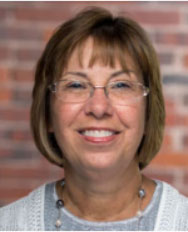 |
Featured Speakers
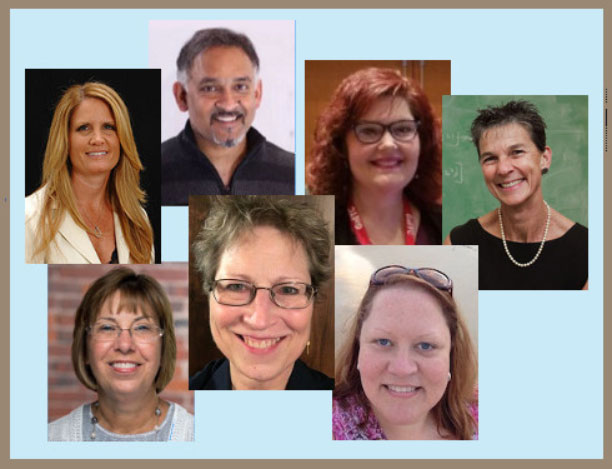
left to right, and top to bottom
Michelle Mikes, GCSM President, Mathematics Supervisor for Cobb
County (and colleagues to include TJ Kaplan, Legislative
Representative, State of Georgia; Terry Haney, RESA Math; Vinnie
Prasad, Mathematics Coach, Cobb County; Angela Stewart, Principal,
Lovinggood MS, Cobb County; Sandi Woodall, Math Program Director,
State of Georgia)
EdCamp-Style Discourse Sessions for Wednesday
afternoon:
From 3-5 p.m., on October 18, 2017, GCTM will offer its first
EdCamp-style discourse sessions at the state math conference. The
focus for these sessions will be to engage participants in a
discussion on new techniques for teaching mathematics, to enrich
their knowledge, and to elevate their understanding of how discourse
promotes mathematical literacy and improves academic practice.
Sessions occur from 3-5 p.m., in the Wildlife Ecology Building.
Sessions offered are determined organically by the participants
during the introductory session (first 20 minutes). In other words,
bring your topics and let's discuss!
For more information on the full EdCamp model, please visit
https://www.edcamp.org/
Back to Top
The Annual Meeting of NCTM
Affiliate Leaders Conference was held in Baltimore, MD on July
22-24, 2017. There were 79 individual participants, representing 37
Affiliates from 26 different states. GCTM was represented by Bonnie
Angel, Denise Huddlestun, Chuck Garner, Kristi Caissie, and Brian
Lack.

The theme of this year's conference was advocacy.
Affiliates had the opportunity to collaborate with one another to
learn more about strategies and efforts for engaging in public and
political advocacy to improve teaching and learning for mathematics
across the United States. On behalf of GCTM, Denise Huddlestun
presented a breakout session on Math Day at the Capitol, and Kristi
Caissie presented on the Summer Math Academies.

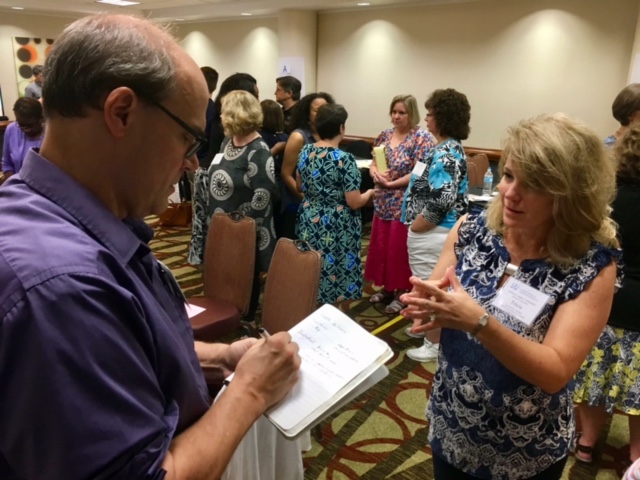
Each Affiliate was also given the opportunity to
create advocacy action plans. The GCTM team penned the following
goal statement: "Teachers need to be equipped with additional
strategies to provide all students access to rich, relevant, and
rigorous learning experiences that address appropriate standards."
To this end, the GCTM team discussed potential initiatives such as
providing more efficient and timely communication to GCTM members
about existing opportunities, as well as diversifying the ways that
GCTM communicates with members. The GCTM Executive Committee will
meet in January to revisit and flesh out the advocacy plan.
Back to Top
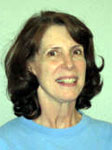 HONORS
& AWARDS HONORS
& AWARDS
John Neff Award
This award is presented to a member of GCTM who demonstrates
excellence as a full time post secondary educator and/or district
supervisor. The recipient is someone who is an inspirer, a mentor,
and an advocate of mathematics and mathematics education.
Awards for Excellence in the Teaching of Mathematics
Three awards, one each for elementary, middle, and secondary levels,
are given to excellent teachers who have strong content foundations
in mathematics appropriate for their teaching level, show evidence
of growth in the teaching of mathematics, and show evidence of
professional involvement in GCTM and NCTM.
If you have any questions or comments about any of the above awards,
please contact Peggy Pool at
awards@gctm.org.
GRANTS
Do you have marvelous ideas for activities and lessons for your
students, but just do not have the materials to implement them in
your classroom because there is no money available through your
school, system, or PTA? GCTM can help!
Mini-Grants
The Mini-Grant program has been implemented to provide funding for
creative teaching projects. Proposals will be judged anonymously,
and grants will be awarded in any amount up to $300.00. Each winner
should be willing to either write an article for Reflections, the
GCTM publication, or participate on a panel with other Mini-Grant
winners at the following Georgia Math Conference.
The criteria upon which applications will be evaluated are:
-
Creativity, innovation
-
Potential impact upon student
achievement
-
Potential for replication by
and dissemination to other teachers
-
Advancement of NCTM's
Principles and Standards for School Mathematics
-
Unavailability of funding
from local sources
Special Projects
GCTM is now offering its members an opportunity to apply for funds
to support large projects that promote the improvement of
mathematics teaching in Georgia. These projects can be focused on
staff development activities, conferences, curriculum development,
task forces, research projects, or other initiatives with similar
impact.
Be sure to make your rationale simple for those voting on your grant
to understand the purpose of your lesson, why you need the items you
are requesting, and why you need help with funding. GCTM wants to
help YOU!
Back to Top
Membership Matters!
 Your
GCTM Executive Board and Georgia Mathematics Conference Board
are very busy preparing for a banner year ahead! Your
GCTM Executive Board and Georgia Mathematics Conference Board
are very busy preparing for a banner year ahead!

Now do your part and renew your
membership! Encourage a colleague! Welcome a new teacher!
Volunteer
Membership stands at about 1400.
We were 3000 strong just a few years ago!
YOU ARE GCTM. Without YOU
we are nothing! Renew today!
Back to Top
Registration for the NCTM Annual
Meeting and Exposition is now open!
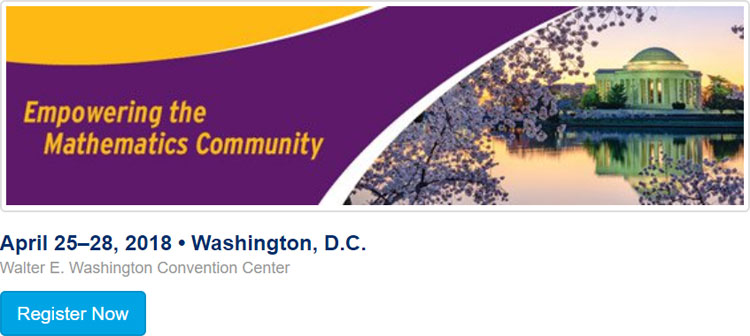
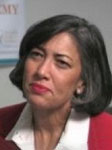 Join thousands of your
mathematics education peers at the premier math education event
of the year! Network and exchange ideas, engage with innovation
in the field, and discover new learning practices that will
drive student success. Join thousands of your
mathematics education peers at the premier math education event
of the year! Network and exchange ideas, engage with innovation
in the field, and discover new learning practices that will
drive student success.
The latest teaching trends
and topics will include:
-
Tools and Technology:
Using Technology to Effectively Teach and Learn
Mathematics
-
Access, Equity, and
Empowerment: Teaching Mathematics with an Equity Stance
-
Purposeful Curriculum:
Cultivating Coherence and Connections
-
Teaching, Learning,
and Curriculum: Best Practices for Engaging Students
-
Assessment: A Tool
for Purposeful Planning and Instruction
-
Professionalism:
Learning Together as Teachers
-
Mathematical Modeling:
Interpreting the World through Mathematics
-
Emerging Issues and
Hot Topics
Back to Top
|
President -
Bonnie Angel
Past President -
Kaycie Maddox
Treasurer
- Nickey Ice
Executive Director -
Tom Ottinger
Membership Director
-
Susan Craig
NCTM Representative
-
Dottie Whitlow
Secretary -
Michelle Mikes
IT Director -
Paul Oser
REFLECTIONS Editor -
Becky Gammill
VP for Advocacy -
Denise Huddlestun
VP for Constitution
and Policy - Joy Darley
VP for Honors and
Awards -
Peggy Pool
VP for Regional
Services - Kristi Caissie
VP for Competitions
-
Chuck Garner
Conference Board
Chair -
Tammy Donalson
|
Back to Top |
Table of Contents
President's Message - by Bonnie
Angel, GCTM President
Advocacy Report 2017 - by Denise
Huddlestun, VP for Advocacy
Treasury
Update - by Nicole Ice, Treasurer
Summer
Academies - by Kristi Caisse
Fractions: Not
Always a Two-Way Street - by Heidi Eisenreich, Ph.D., Ha Nguyen,
Ph.D., Joy Darley, Ph.D.
Interactive Whiteboard use Outside the Classroom - by Andrew
Shealy
Balancing the Equation - by
Michelle Mikes, GCTM Secretary
A
Special Geometry Note from the Summer Academies -
by Jeff McCammon, East Metro Region Representative
GMC Update -
by Dr. David W. Thacker, GMC Program Chairperson
NCTM Affiliate
Conference (Summer 2017) - by Brian Lack, Advocacy VP Intern
Awards and
Grants - by Peggy Pool, VP Honors and Awards
GCTM
Membership Report - by Susan Craig Membership Director
NCTM Report
-
by Dottie Whitlow, NCTM Representative
GCTM Executive Board
|
















 Are we teaching NEW, NEW Math?? Our math
standards and methods for teaching have been controversial since
1788 regarding teaching conceptually vs. skills and practice. Dottie
Whitlow gave a great review of the history component in the book
Balancing the Equation written by current NCTM President, Matt
Larsen and author Tim Kanold in the spring edition of Reflections
this year. She shared the history of the pendulum shift for over 200
years on how students should learn mathematics.
Are we teaching NEW, NEW Math?? Our math
standards and methods for teaching have been controversial since
1788 regarding teaching conceptually vs. skills and practice. Dottie
Whitlow gave a great review of the history component in the book
Balancing the Equation written by current NCTM President, Matt
Larsen and author Tim Kanold in the spring edition of Reflections
this year. She shared the history of the pendulum shift for over 200
years on how students should learn mathematics.

 After
the first day's sessions, I gave the participants an opportunity to
ask questions anonymously to make sure we covered as many topics as
possible on the second day. A common question was "could we go over
strategies to cover the standards most effectively for the EOC
Milestone?" Although our seminar focus was not to do "teaching to
the test" strategies, the question is a legitimate concern in this
era of high stakes testing. In response to this question, I thought
about some of the practices I use in the classroom to teach material
as it would naturally develop or make sense in the learning process.
When I look at a curriculum map, such as the one developed for
Geometry, I try to consider why we teach the topics in that
particular order or whether there is a better logical way to
approach the standards that would make sense to my students.
After
the first day's sessions, I gave the participants an opportunity to
ask questions anonymously to make sure we covered as many topics as
possible on the second day. A common question was "could we go over
strategies to cover the standards most effectively for the EOC
Milestone?" Although our seminar focus was not to do "teaching to
the test" strategies, the question is a legitimate concern in this
era of high stakes testing. In response to this question, I thought
about some of the practices I use in the classroom to teach material
as it would naturally develop or make sense in the learning process.
When I look at a curriculum map, such as the one developed for
Geometry, I try to consider why we teach the topics in that
particular order or whether there is a better logical way to
approach the standards that would make sense to my students.  For
example, in my earlier years of teaching the standards on Geometric
Constructions, I would take a few days with a class set of compasses
in tow and cover every construction that could possibly be asked on
the EOC Milestone. We might pause to enjoy a few extraneous
constructions such as the 6 petal "flower" (which leads to the
hexagon). When we had more time for projects (before Milestones), I
would even assign students to construct their own snowflake using
geometric constructions. Yet overall, constructions was a unit of
its own with little connection to the other geometric topics.
For
example, in my earlier years of teaching the standards on Geometric
Constructions, I would take a few days with a class set of compasses
in tow and cover every construction that could possibly be asked on
the EOC Milestone. We might pause to enjoy a few extraneous
constructions such as the 6 petal "flower" (which leads to the
hexagon). When we had more time for projects (before Milestones), I
would even assign students to construct their own snowflake using
geometric constructions. Yet overall, constructions was a unit of
its own with little connection to the other geometric topics.
 This
year's theme is "Communicating Mathematics: Creating a Culture for
Discourse Fluency."
This
year's theme is "Communicating Mathematics: Creating a Culture for
Discourse Fluency."









 Join thousands of your
mathematics education peers at the premier math education event
of the year! Network and exchange ideas, engage with innovation
in the field, and discover new learning practices that will
drive student success.
Join thousands of your
mathematics education peers at the premier math education event
of the year! Network and exchange ideas, engage with innovation
in the field, and discover new learning practices that will
drive student success.